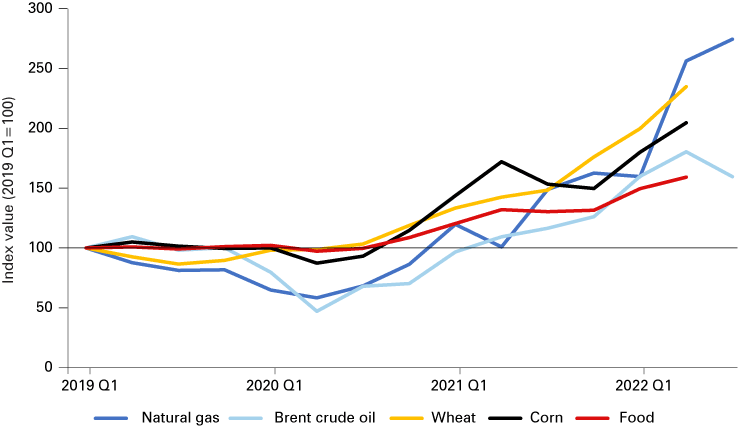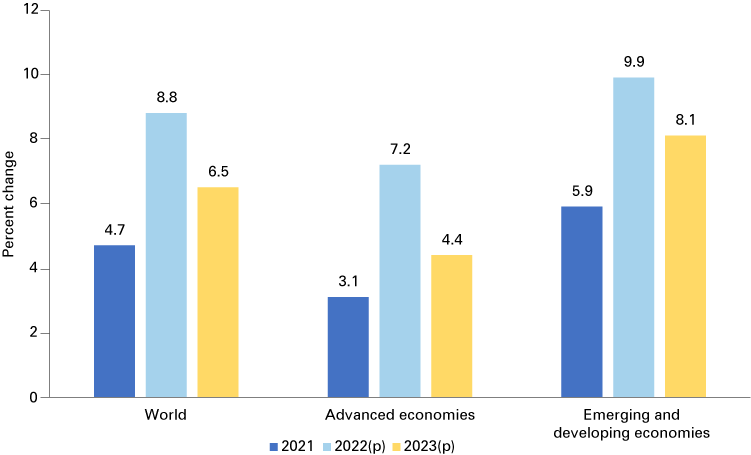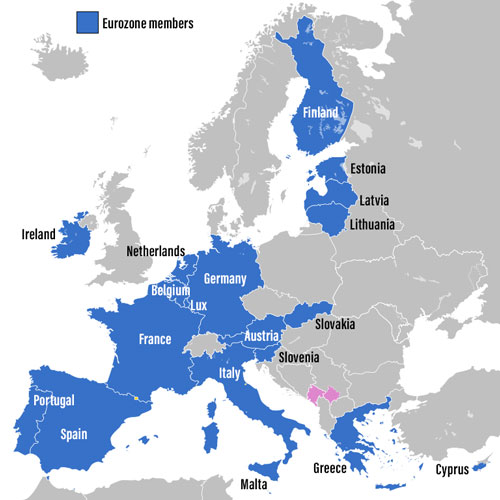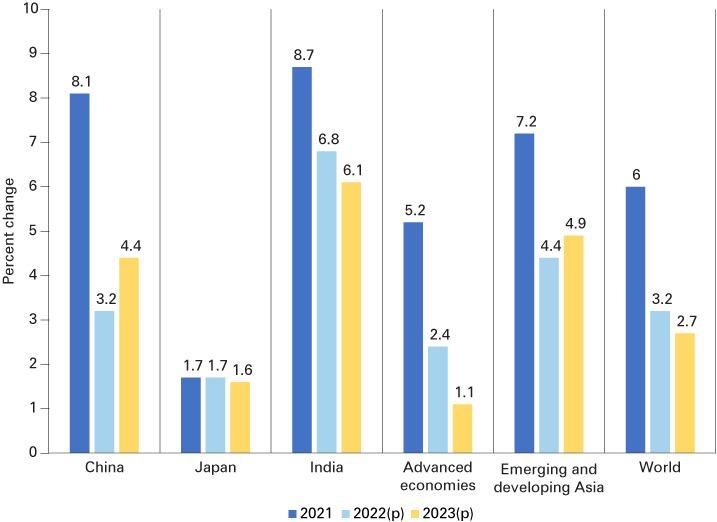
International outlook for 2023

Assistant Professor, Kelley School of Business, Indiana University

Senior Lecturer, Kelley School of Business, Indiana University
Introduction
The international outlook for the last two years has been rendered with high degrees of uncertainty. The outlook for 2023 proves to be more of the same—albeit for different reasons.
Over the course of 2022, the COVID-19 pandemic—through the surge in cases associated with the omicron variant—demonstrated once again its potential to wreak havoc on the global economy. The omicron surge that began 2022 was also accompanied with the retirement of many of the expansionary fiscal and monetary policy responses to the pandemic. Consequently, most countries’ economies are expected to have experienced slower growth in 2022 relative to 2021.
To make matters worse, inflationary pressures, which also began for many countries in the middle of 2021, have now become more pervasive and persistent than many initially expected. These inflationary pressures partly reflect the extremely tight labor markets in many countries, and the continued supply-chain pressures that have only been more strained—especially for food and energy—as a consequence of the Russian war in Ukraine (see Figure 1).
Figure 1: Global energy and food prices

Note: Natural gas and Brent crude oil data is available through 2022 Q3, while wheat, corn and food are only available through 2022 Q1.
Source: International Monetary Fund, Energy Information Administration and authors’ calculations
In addition to these factors, monetary policy institutions across the world, including the Federal Reserve and European Central Bank, initiated a sequence of interest rate increases that have raised nominal rates to levels not seen since leading into the financial crisis. In an effort to combat the inflationary pressures being experienced globally (see Figure 2), these interest rate increases have begun to have effects in interest rate-sensitive sectors (e.g., housing), but have also had some voice concerns that they will ultimately result in a global recession in the near term.
The IMF expects growth in the global economy to continue into 2023 at a rate of 2.7% coming off projected growth in 2022 of 3.2%. The outlook for growth in 2023 has become more pessimistic over the last two quarters as most signs indicate the efforts to curb inflation could be more aggressive than originally anticipated. The continued increase in interest rates, coupled with geopolitical shocks (e.g., the war in Ukraine) that might unsettle financial and energy markets, presents significant challenges for the global economy going forward.
Figure 2: Global inflation

Note: (p) indicates a projection.
Source: International Monetary Fund: World Economic Outlook, Table 1.1
United States
Growth in the U.S. is expected to decline in 2022 to near 1.6%. Growth in 2023 is expected to fall still to a rate of 1.0%. If realized, this would mean the U.S. economy would spend much of 2022 and 2023 below trend growth.
The U.S. economy is also facing significant challenges with inflationary pressures. Latest readings of both total Consumer Price Index (CPI) and core CPI are coming in at year-over-year rates of 8.2% and 6.6%, respectively. The breadth and persistence of the inflationary pressures has emboldened the Federal Reserve to increase interest rates and economists on average expect the Fed to continue to increase rates to a level near 4.5% by the middle of 2023. The increasing strength of the U.S. dollar is also expected to put a drag on exports’ contribution to growth over the near term.
So, while some sectors of the U.S. economy remain strong—most notably the labor market with the unemployment rate near a record low—many economists are projecting an elevated likelihood of a recession over the next 12 to 18 months.
Eurozone

The Eurozone is projected to grow 3.1% during 2022. Despite not being as much of a slowdown as that of the U.S., this growth masks a considerable amount of divergence within the Eurozone. For instance, Italy and Spain, bolstered by a return to tourism, are projected to experience growth of 3.2% and 4.3%, respectively, in 2022. Alternatively, France and Germany are expected to grow by 2.5% and 1.5%, respectively.
Going forward, the outlook for growth in the Eurozone has considerable downsides. With the continued economic and human losses brought on by the Russian war on Ukraine, European countries most sensitive to the ongoing war are likely to have their economies suffer. In conjunction with the war, the European Central Bank has begun increasing interest rates and is expected to continue to combat the inflationary pressures also being experienced there. For these reasons, the IMF projects the Eurozone to grow at a mere 0.5% in 2023, with the economies of Germany and Italy contracting at rates of -0.3% percent and -0.2%, respectively.
Britain
Outside of the Russian war in Ukraine, the country with the most recent political uncertainty is undoubtedly the United Kingdom. As of the writing of this article, Liz Truss, the prime minister that took over in September, has resigned after being in leadership for just 44 days. Despite being the shortest-serving prime minister in U.K. history, Truss’s time in office was anything but uneventful. Her stint included the death of the Queen of England, a proposed-then-abandoned economic plan that was largely at the center of turmoil in the U.K. financial markets, all amidst some of the highest inflation the country has experienced in 40 years.
Since then, Rishi Sunak has become prime minister and faces what he describes as “a profound economic crisis” that has manifested from COVID-19, the war in Ukraine and the prior prime minister’s mistakes. Despite these challenges, the United Kingdom is expected to grow at a rate of 3.6% in 2022. The outlook for 2023 includes a further slowdown in growth to 0.3%, as the Bank of England battles inflation rates that are at unprecedented levels.
North American trading partners
Growth in Canada is expected to come in at 3.3% for 2022, with Mexico coming in slightly weaker at 2.1%. In both cases, growth is expected to decrease in 2023, coming in at 1.5% for Canada and 1.2% for Mexico. Both countries have experienced elevated rates of inflation, with Mexico experiencing more exposure to the increases in food and energy prices (see Figure 1) brought on by the war in Ukraine. With both countries experiencing significant increases in inflation, the outlook for growth has been downgraded for both countries. For each, tighter monetary policy and weakness abroad are likely to produce headwinds for growth over the medium term.
China
China’s economy is expected to grow at 3.2% during 2022, a significant decline from 8.1% in 2021. Although China’s growth is higher than the expected growth in the U.S. and Eurozone for 2022, it marks the lowest growth for China in over 40 years, except for the 2020 COVID slowdown. The economic decline has been caused more by internal economic factors rather than external economic factors, such as global inflation and the Russian war on Ukraine.
The weaker economy is due in part to a 7% contraction in the real estate market during the second quarter of 2022. The property crisis, considered the worst in the history of China, is having widespread effects across all sectors of the economy. Large loan losses and credit stress are generating concern for a potential banking crisis for the world’s second-largest economy. A resurgence of strict COVID-related restrictions and lockdowns are causing reduced consumption. That, along with declining consumer confidence, is contributing to a significant slowdown in the Chinese economy.
Moving forward, the IMF projects a slight recovery for China, reaching 4.4% growth during 2023. However, this relies heavily on China’s strategy in dealing with the COVID crisis, as this is a driving force in their current economic decline.
Considering China is a significant trading partner in the world economy, their weaker economy and reduced output could potentially result in additional supply-chain disruptions, thus adding to global economic slowdowns.
Figure 3: Selected Asian countries and the world: Real GDP change

Note: (p) indicates a projection.
Source: International Monetary Fund: World Economic Outlook, Table 1.1
India
After showing the strongest recovery among the G20 during 2021, India is expected to grow at a slower rate of 6.8% during 2022, and has experienced slower growth rates each quarter throughout 2022. Although the IMF projects India to grow at 6.1% in 2023, higher than all advanced economies and emerging markets/developing economies (see Figure 3), concern exists that 2023 actual growth will be lower.
In addition to global issues, such as rising energy prices and COVID, internal issues, such as inflation, weak employment and falling industrial activity, will likely have a negative impact on India’s growth in 2023. Due to continuing interest rate increases by the central bank, a depreciating rupee and deterioration of other global economies, India’s growth is likely to be smaller than expected.
Japan
Economic growth in Japan is expected to remain stable at 1.7% in 2022, with only a slight expected decrease to 1.6% in 2023. Japan’s economy has remained relatively immune to the global economic woes during 2022, but moving forward into 2023 with continuing inflation resulting in increased prices for raw materials and higher living costs, along with potential supply-chain disruptions, the Japanese economy may begin to experience a greater impact if global economic conditions continue to deteriorate.
Conclusion
The task of projecting the path of the global economy over the next 12 to 15 months is a difficult one. While we expect growth in the global economy to continue into 2023 at a rate of 2.7%, our outlook for this growth is more pessimistic than in years past. Unexpected weakness abroad—especially in China—and the possibility of an even more prolonged war in Ukraine leaves several downside risks to the outlook as well. Moreover, monetary policy institutions across the globe also have the unenviable task of trying to slow down demand enough to bring inflation back to target levels, all the while not tipping the global economy into a full-on contraction.
References
- Cambon, Sarah C. “U.S. economy grew 2.6% in third quarter, GDP report shows.” Wall Street Journal, October 27, 2022. https://www.wsj.com/articles/us-gdp-economic-growth-third-quarter-2022-11666830253
- Colchester, Max. “U.K. Prime Minister Liz Truss battles to hang on after budget U-turn.” Wall Street Journal, October 16, 2022. https://www.wsj.com/articles/u-k-prime-minister-liz-truss-battles-to-hang-on-after-budget-u-turn-11665939908
- International Monetary Fund. “World economic outlook, October 2022: Countering the cost-of-living crisis.” October 2022. https://www.imf.org/en/Publications/WEO/Issues/2022/10/11/world-economic-outlook-october-2022
- International Monetary Fund. “World economic outlook, October 2021: Recovery during a pandemic.” October 2021. www.imf.org/en/Publications/WEO/Issues/2021/10/12/world-economic-outlook-october-2021
- Feng, Rebecca and Cao Li. “The bursting Chinese housing bubble compounds Beijing’s economic woes.” Wall Street Journal, August 11, 2022. https://www.wsj.com/articles/bursting-chinese-housing-bubble-compounds-beijings-economic-woes-11660235003?mod=article_inline
- Hayashi, Yuka. “IMF cuts 2023 global growth forecast, citing inflation, war and China slowdown.” Wall Street Journal, October 11, 2022. https://www.wsj.com/articles/imf-cuts-2023-global-growth-forecast-citing-inflation-war-and-china-slowdown-11665463695
- Mishra, Vivek. “India’s economic growth outlook stagnates, stuck in lower gear – Reuters poll.” Reuters, October 19, 2022. https://www.reuters.com/world/india/indias-economic-growth-outlook-stagnates-stuck-lower-gear-2022-10-20/
- Torry, Harriet. “Economists now expect a recession, job losses by next year.” Wall Street Journal, Oct. 16, 2022. https://www.wsj.com/articles/economists-now-expect-a-recession-job-losses-by-next-year-11665859869?mod=article_inline
- Xie, Stella Yifan. “China’s COVID-19 lockdowns deal another blow to consumer spending.” Wall Street Journal, October 10, 2022. https://www.wsj.com/articles/chinas-covid-lockdowns-deal-another-blow-to-consumer-spending-11665386341?mod=article_inline



